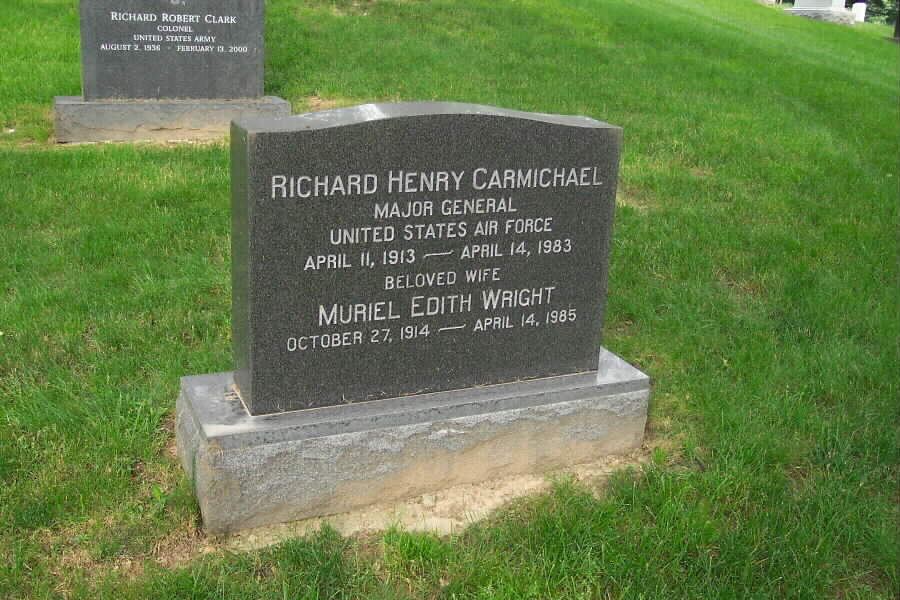MAJOR GENERAL RICHARD H. CARMICHAEL
Retired January 19, 1961. Died April 14, 1983.
Richard Henry Carmichael was born in Hillsboro, Texas, in 1913. He graduated from San Antonio High School in 1930 and received a congressional appointment to West Point. He graduated in the class of 1936, 92nd in a class of 278.
Following graduation, Lieutenant Carmichael of the Field Artillery proceeded to Randolph Field, Texas where he graduated from flying school and received his pilot wings in 1937. Today he is a rated command pilot. By far, most of his flying time has been accomplished in multi-engine type aircraft.
During the period 1937-1941, he served in varied flying assignments including Hawaii, Fort Douglas, Utah and Hamilton Field, California. He departed Hamilton Field Dec. 6, 1941, arriving at Hickam Field the morning of December 7, 1941 with his squadron of B-17s. Major Carmichael found that hostilities had begun and a heavy aerial attack was in progress. By expert flying skill he landed his B-17 on an emergency field of 1,200 feet and quickly placed it in a dispersal area. For this General MacArthur awarded him with his first of two Distinguished Flying Crosses.
As commander of the 19th Bomb Group, Colonel Carmichael participated in some 25 combat missions against the Japanese. An excerpt from his Distinguished Service Cross reads, “Although both his side gunners were killed and his airplane heavily damaged, he continued to press home the attack.” The courageous and effective leadership of the group resulted in the shooting down of 11 enemy fighters and in the destruction, or severe damage to 50 bombers on the ground.
Returning to the Zone of Interior in November 1942, he served as executive assistant to General Hap Arnold at Army Air Force headquarters until assuming command of the 462nd Bomb Group. While leading his group in a B-29 attack on Yawata, Japan Aug. 20, 1944, the first daylight raid on Japan, he was shot down and remained a prisoner of war until he was liberated Aug. 29, 1945.
Following a period of hospitalization, he attended the Air Command and Staff School. After graduation he served on the Air University staff as chief of the Air Power Employment Branch, Evaluation Division. In June 1949, he assumed command of the 11th Bomb Group and April 1, 1950, he was assigned as commander of the 98th Bomb Group. The Korean action found him piling up another 39 combat missions, good for 363 hours as combat commander of the 98th. Returning to the States in April 1951, he was assigned as commander of the 93d Bomb Wing and in October 1951, he was reassigned to Travis to take command of the 14th Air Division at Travis Air Force Base, California.
General Carmichael returned to the Far East as commander of the FEAF Bomber Command in May of 1953. He was reassigned to Headquarters U.S. Air Force as deputy director of personnel procurement and training in May of 1953 and was made Director on Jan. 1, 1955. On July 11, 1958 he assumed his present job, that of commandant of the Air University’s Air Command and Staff College.
DECORATIONS AND MEDALS
Distinguished Service Cross with oak leaf cluster
British Distinguished Flying Cross
Legion of Merit with four oak leaf clusters
Silver Star with oak leaf cluster
Distinguished Flying Cross with oak leaf cluster
Air Medal with three oak leaf clusters
Distinguished Unit Citations with four oak leaf clusters
Asiatic Pacific Theater with bronze stars
American Defense Medal with star
American Theater
World War II Victory Medal
Occupation Medal
Korean Service Medal with four bronze stars
United Nations Service Medal
Air Force Longevity Service Award
Republic of Korea Unit Citation
OPINIONS, TASTES AND EVALUATIONS
Is a conservative dresser with no color preference. Is partial to Spanish type cooking. Enjoys curries.
Reading interests are varied. Is a student of Douhey and other airpower leaders. Is undecided on place of retirement.
“With the amount of effort required to be outstanding instead of average, any individual who remains average tends to be lazy,” is one of the general’s comments which best describe him. Another expression used to describe his position on the motto of any job worth doing is worth doing right is “Either I go first class or stay home.”
He stresses loyalty both up and down the chain of command. Is a firm advocate of the position of “Fail to honor the men and they will fail to honor you.”
Is a stickler for flying safety compliance. Is known by all who have served him as having a flair for remembering names, places and dates. Senior non-commissioned officers have often called him an airmen’s general. Places great emphasis on the morale and well being of his people.
General Carmichael is buried in Section 30 of Arlington National Cemetery. His wife, Murial Edith Wright Carmichael (27 October 1914-14 April 1985) is buried with him.
Michael Robert Patterson was born in Arlington and is the son of a former officer of the US Army. So it was no wonder that sooner or later his interests drew him to American history and especially to American military history. Many of his articles can be found on renowned portals like the New York Times, Washingtonpost or Wikipedia.
Reviewed by: Michael Howard

